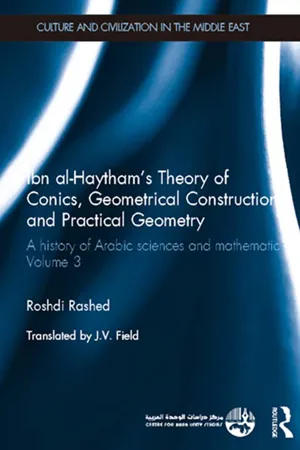
Ibn al-Haytham's Theory of Conics, Geometrical Constructions and Practical Geometry
A History of Arabic Sciences and Mathematics Volume 3
- 776 pages
- English
- ePUB (mobile friendly)
- Available on iOS & Android
Ibn al-Haytham's Theory of Conics, Geometrical Constructions and Practical Geometry
A History of Arabic Sciences and Mathematics Volume 3
About this book
Theory of Conics, Geometrical Constructions and Practical Geometry: A History of Arabic Sciences and Mathematics Volume 3, provides a unique primary source on the history and philosophy of mathematics and science from the mediaeval Arab world. The present text is complemented by two preceding volumes of A History of Arabic Sciences and Mathematics, which focused on founding figures and commentators in the ninth and tenth centuries, and the historical and epistemological development of 'infinitesimal mathematics' as it became clearly articulated in the oeuvre of Ibn al-Haytham.
This volume examines the increasing tendency, after the ninth century, to explain mathematical problems inherited from Greek times using the theory of conics. Roshdi Rashed argues that Ibn al-Haytham completes the transformation of this 'area of activity, ' into a part of geometry concerned with geometrical constructions, dealing not only with the metrical properties of conic sections but with ways of drawing them and properties of their position and shape.
Including extensive commentary from one of world's foremost authorities on the subject, this book contributes a more informed and balanced understanding of the internal currents of the history of mathematics and the exact sciences in Islam, and of its adaptive interpretation and assimilation in the European context. This fundamental text will appeal to historians of ideas, epistemologists and mathematicians at the most advanced levels of research.
Frequently asked questions
- Essential is ideal for learners and professionals who enjoy exploring a wide range of subjects. Access the Essential Library with 800,000+ trusted titles and best-sellers across business, personal growth, and the humanities. Includes unlimited reading time and Standard Read Aloud voice.
- Complete: Perfect for advanced learners and researchers needing full, unrestricted access. Unlock 1.4M+ books across hundreds of subjects, including academic and specialized titles. The Complete Plan also includes advanced features like Premium Read Aloud and Research Assistant.
Please note we cannot support devices running on iOS 13 and Android 7 or earlier. Learn more about using the app.
Information
CHAPTER I
THEORY OF CONICS AND GEOMETRICAL CONSTRUCTIONS: ‘COMPLETION OF THE CONICS’
1.1. INTRODUCTION
1.1.1. Ibn al-Haytham and Apollonius’ Conics
Table of contents
- Cover
- Half Title
- CULTURE AND CIVILIZATION IN THE MIDDLE EAST
- Title Page
- Copyright Page
- Table of Contents
- Foreword
- Preface
- INTRODUCTION: CONIC SECTIONS AND GEOMETRICAL CONSTRUCTIONS
- CHAPTER I: THEORY OF CONICS AND GEOMETRICAL CONSTRUCTIONS: 'COMPLETION OF THE CONICS'
- CHAPTER II: CORRECTING THE BANŪ MŪSĀ'S LEMMA FOR APOLLONIUS' CONICS
- CHAPTER III: PROBLEMS OF GEOMETRICAL CONSTRUCTION
- CHAPTER IV: PRACTICAL GEOMETRY: MEASUREMENT
- APPENDIX I: A RESEARCH TRADITION: THE REGULAR HEPTAGON
- APPENDIX II: SINĀN IBN AL-FATH AND AL-QABĪSĪ: OPTICAL MENSURATION
- SUPPLEMENTARY NOTES
- ADDENDA (vol. 2) Al-Hasan ibn al-Haytham and Muhammad ibn al-Haytham: the Mathematician and the Philosopher
- BIBLIOGRAPHY
- INDEXES